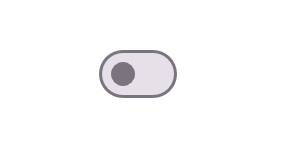Getting Started with .NET MAUI Switch
24 Jul 202512 minutes to read
This section guides you through setting up and configuring a SfSwitch in your .NET MAUI application. Follow the steps below to add a basic SfSwitch to your project.
To quickly get started with the .NET MAUI Switch, watch this video.
Prerequisites
Before proceeding, ensure the following are set up:
- Install .NET 8 SDK or later.
- Set up a .NET MAUI environment with Visual Studio 2022 (v17.3 or later).
Step 1: Create a new .NET MAUI project
- Go to File > New > Project and select the .NET MAUI App template.
- Name the project, choose a location, and click Next.
- Select the .NET framework version and click Create.
Step 2: Install the Syncfusion® MAUI Buttons NuGet package
- In Solution Explorer, right-click the project and select Manage NuGet Packages.
- Search for Syncfusion.Maui.Buttons and install the latest version.
- Ensure all necessary dependencies are installed correctly, and the project is restored.
Step 3: Register the handler
Syncfusion.Maui.Core NuGet is a dependent package for all Syncfusion® controls in .NET MAUI. In the MauiProgram.cs file, register the handler for Syncfusion® core.
using Microsoft.Extensions.Logging;
using Syncfusion.Maui.Core.Hosting;
namespace SwitchGettingStarted
{
public static class MauiProgram
{
public static MauiApp CreateMauiApp()
{
var builder = MauiApp.CreateBuilder();
builder
.UseMauiApp<App>()
.ConfigureSyncfusionCore()
.ConfigureFonts(fonts =>
{
fonts.AddFont("OpenSans-Regular.ttf", "OpenSansRegular");
});
return builder.Build();
}
}
}Step 4: Adding the .NET MAUI Switch
- Import the Buttons namespace into your code to initialize the control.
- Initialize SfSwitch.
<ContentPage
. . .
xmlns:buttons="clr-namespace:Syncfusion.Maui.Buttons;assembly=Syncfusion.Maui.Buttons">
<buttons:SfSwitch x:Name="sfSwitch" />
</ContentPage>using Syncfusion.Maui.Buttons;
namespace SwitchGettingStarted
{
public partial class MainPage : ContentPage
{
public MainPage()
{
InitializeComponent();
SfSwitch sfSwitch = new SfSwitch();
this.Content= sfSwitch;
}
}
}
Prerequisites
Before proceeding, ensure the following are set up:
- Install .NET 8 SDK or later.
- Set up a .NET MAUI environment with Visual Studio Code.
- Ensure that the .NET MAUI extension is installed and configured as described here.
Step 1: Create a new .NET MAUI project
- Open the command palette by pressing
Ctrl+Shift+Pand type .NET:New Project and enter. - Choose the .NET MAUI App template.
- Select the project location, type the project name and press Enter.
- Then choose Create project.
Step 2: Install the Syncfusion® MAUI Buttons NuGet package
- Press Ctrl + ` (backtick) to open the integrated terminal in Visual Studio Code.
- Ensure you’re in the project root directory where your .csproj file is located.
- Run the command
dotnet add package Syncfusion.Maui.Buttonsto install the Syncfusion® .NET MAUI Buttons package. - To ensure all dependencies are installed, run
dotnet restore.
Step 3: Register the handler
Syncfusion.Maui.Core NuGet is a dependent package for all Syncfusion® controls of .NET MAUI. In the MauiProgram.cs file, register the handler for Syncfusion® core.
using Microsoft.Extensions.Logging;
using Syncfusion.Maui.Core.Hosting;
namespace SwitchGettingStarted
{
public static class MauiProgram
{
public static MauiApp CreateMauiApp()
{
var builder = MauiApp.CreateBuilder();
builder
.UseMauiApp<App>()
.ConfigureSyncfusionCore()
.ConfigureFonts(fonts =>
{
fonts.AddFont("OpenSans-Regular.ttf", "OpenSansRegular");
});
return builder.Build();
}
}
}Step 4: Adding the .NET MAUI Switch
- Import the Buttons namespace into your code to initialize the control.
- Initialize SfSwitch.
<ContentPage
. . .
xmlns:buttons="clr-namespace:Syncfusion.Maui.Buttons;assembly=Syncfusion.Maui.Buttons">
<buttons:SfSwitch x:Name="sfSwitch" />
</ContentPage>using Syncfusion.Maui.Buttons;
namespace SwitchGettingStarted
{
public partial class MainPage : ContentPage
{
public MainPage()
{
InitializeComponent();
SfSwitch sfSwitch = new SfSwitch();
this.Content= sfSwitch;
}
}
}
Prerequisites
Before proceeding, ensure the following are set up:
- Ensure you have the latest version of JetBrains Rider.
- Install .NET 8 SDK or later.
- Make sure the MAUI workloads are installed and configured as described here.
Step 1: Create a new .NET MAUI project
- Go to File > New Solution, Select .NET (C#) and choose the .NET MAUI App template.
- Enter the Project Name, Solution Name, and Location.
- Select the .NET framework version and click Create.
Step 2: Install the Syncfusion® MAUI Buttons NuGet package
- In Solution Explorer, right-click the project and choose Manage NuGet Packages.
- Search for Syncfusion.Maui.Buttons and install the latest version.
- Ensure the necessary dependencies are installed correctly, and the project is restored. If not, Open the Terminal in Rider and manually run:
dotnet restore.
Step 3: Register the handler
Syncfusion.Maui.Core NuGet is a dependent package for all Syncfusion® controls of .NET MAUI. In the MauiProgram.cs file, register the handler for Syncfusion® core.
using Microsoft.Extensions.Logging;
using Syncfusion.Maui.Core.Hosting;
namespace SwitchGettingStarted
{
public static class MauiProgram
{
public static MauiApp CreateMauiApp()
{
var builder = MauiApp.CreateBuilder();
builder
.UseMauiApp<App>()
.ConfigureSyncfusionCore()
.ConfigureFonts(fonts =>
{
fonts.AddFont("OpenSans-Regular.ttf", "OpenSansRegular");
});
return builder.Build();
}
}
}Step 4: Adding the .NET MAUI Switch
- Import the Buttons namespace into your code to initialize the control.
- Initialize SfSwitch.
<ContentPage
. . .
xmlns:buttons="clr-namespace:Syncfusion.Maui.Buttons;assembly=Syncfusion.Maui.Buttons">
<buttons:SfSwitch x:Name="sfSwitch" />
</ContentPage>using Syncfusion.Maui.Buttons;
namespace SwitchGettingStarted
{
public partial class MainPage : ContentPage
{
public MainPage()
{
InitializeComponent();
SfSwitch sfSwitch = new SfSwitch();
this.Content= sfSwitch;
}
}
}
Performing an action based on state
You can switch between states in the .NET MAUI Switch control. When the state changes,the StateChanging and StateChanged events are triggered. These events allow you to perform specific actions depending on the current state of the Switch. The StateChanging event also allows you to cancel the transition to a new state if needed.
The following code example displays a message box when the .NET MAUI Switch is switched to the off state after the work is completed.
<buttons:SfSwitch x:Name="sfSwitch" StateChanged="OnSwitchStateChanged"/>SfSwitch sfSwitch = new SfSwitch();
sfSwitch.StateChanged+= OnSwitchStateChanged;
this.Content = sfSwitch;private void OnSwitchStateChanged(object sender, SwitchStateChangedEventArgs e)
{
DisplayAlert("Message", "SUCCESS", "OK");
}NOTE
Find the complete getting started sample of the .NET MAUI Switch from this link.
NOTE
Refer to our .NET MAUI Switch feature tour page for its groundbreaking feature representations. Explore our .NET MAUI Switch example for rendering the .NET MAUI Switch.